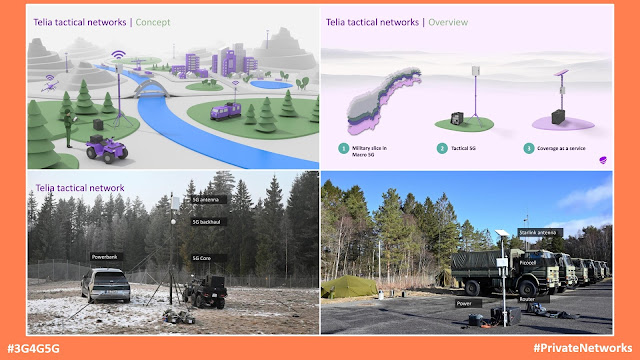In June 2022, Telia Norway and the Norwegian Defense Materiel Agency announced that they have entered into collaboration on developing tactical private 5G networks, as well as a virtual private network implemented as a part of Telia Norway’s national 5G network. The press release said:
We have tested 5G for several years to explore how the defense sector can benefit from the technology. We are now taking another step forward by entering into agreements with commercial mobile operators to develop tactical, private 5G networks that can be combined with the national 5G networks currently being established," says Eiliv Ofigsbø, head of CIS division at the Norwegian Defense Materiel Agency.
A private network of this kind can be operated separately while also being connected to Telia Norway's national 5G network. By combining existing infrastructure and a separate tactical network the objective is to build a communication solution that is both secure, resilient, and flexible.
At the Future Enterprise Networks conference in London, Henning Huuse, 5G Business Development Manager at Telia gave a presentation on Tactical 5G for critical communication in the Norwegian Armed Forces. Light Reading reported, quoting Henning:
"Cellular networks are very resilient," he added. "Basestations can be shot one by one but it's difficult because they are spread all over the country."
Such considerations explain why Norway's own armed forces approached Telia about two years ago, asking for a service based not on proprietary technology but on the same 5G standard used by civilians. Their requirements for performance, security and reliability sounded familiar to Huuse, who had already worked on the development of private 5G networks for non-military enterprises. By ringfencing a part of Telia's public 5G network to provide service guarantees – a process known as network slicing – Huuse believed Telia could satisfy the demands of Norway's armed forces just as it would those of a typical client.
Telia Tactical Networks for Military #EnterpriseNetworks #PrivateNetworks #FENevent #Private5G #5G pic.twitter.com/Lqk1MNTso1
— Private Networks (@PrivNetTech) June 13, 2023
He turned out to be right. A unit called Telia Tactical Networks does now manage a 5G slice for the Norwegian armed forces, roping off sensitive data and providing service guarantees. On top of that, Telia has been developing a portable kit, in partnership with its suppliers, to provide connectivity for military operations.
Two mock-ups of movable cell towers were shown at Future Enterprise Networks. The larger one uses the same 5G antenna from Ericsson that would typically feature on rooftops in city centers. At the base of the tower, a black box hosts a battery as well as various computing resources. Those include Ericsson's radio access network software and a full "core" network designed by Athonet, an Italian vendor recently acquired by HPE. It is, essentially, a complete 5G network, providing connectivity over a radius of about five kilometers.
The smaller tower, which limits coverage to about one kilometer, comes with a battery and picocell, a unit normally deployed indoors. It appears to lack a separate core but does feature a Starlink antenna for satellite backhaul to the Telia network. Developed just a few months ago, it could be of interest to organizations besides the Norwegian armed forces operating in areas where there is simply no network alternative, says Huuse.
SIM management is still a concern in cases where soldiers like Ukraine's Dasha are bringing their own devices. The simplest solution today would involve issuing a separate SIM card for connecting to the tactical network, said Huuse. Ideally, however, Telia wants to be able to onboard devices to the military slice without hardware changes. This could be done by having users scan a QR code, giving a device management system control of the phone. The need for such functionality in Norway is driven largely by its home guard, formed of people who spend only a few days each year as soldiers. "We are not there yet," said Huuse. "That is the end game."
In the meantime, Telia is also still figuring out its own working relationship with the Norwegian armed forces. "We know how to handle a crisis and we have critical infrastructure, but we have never done it in wartime," said Huuse. "The challenge from the armed forces is see how far you can go. If we have to dress in uniform to do the job, we'll have to figure that out."
We will surely hear more on this topic in the near future.
Related Posts:
- Private Networks Technology Blog: Private Networks are Popular in Manufacturing, Education and Mining

Comments
Post a Comment